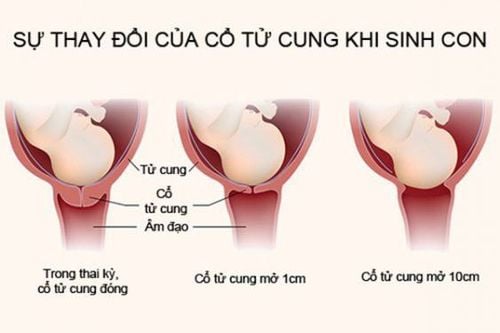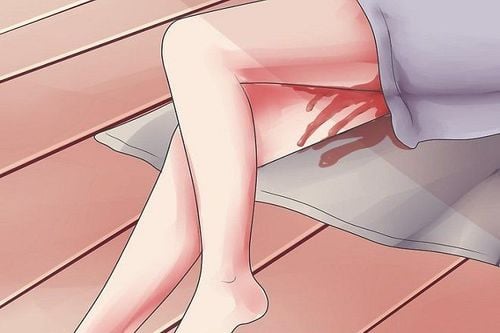This is an automatically translated article.
The article was professionally consulted by Specialist Doctor I Pham Thi Yen - Obstetrics and Gynecology Department - Vinmec Hai Phong International General HospitalThe cervix is the opening part before entering the uterine cavity and is also a place that is quite susceptible to trauma due to the procedure, especially during labor and vaginal delivery. Accordingly, cervical tear needs to be treated immediately after the end of labor to prevent complications as well as limit future outcomes.
1. What is cervical tear?
The uterus is an organ made up of thick layers of smooth muscle, where the fertilized egg implants and develops until the fetus matures. The uterus has a truncated cone shape, the base is wide above and the apex is turned downward, consisting of three parts: the body of the uterus, the isthmus of the uterus and the cervix.
Normal cervix is 2 to 3cm long, 2cm wide. At birth, the cervix and the external orifice are round and solid. After giving birth once, the cervix is flattened, the outer hole is slightly wider, no longer round as before, and the density is softer. With multiple births, the ectopic opening of the cervix will widen horizontally.

During labor, under the action of uterine contractions, the cervix changes from a cylindrical shape to a thin sheet. It is the phenomenon of cervical erasure and will combine with the opening of the cervix, establishing the lower uterine segment, creating conditions for the fetus to be easily expelled. At this time, for any reason, causing the perineum to expand too much or having a surgical intervention during delivery will easily lead to cervical tear complications.
Cervical tear may be a solitary lesion or may be associated with vaginal and perineal tears. In addition, the classification of cervical tear depends on the location of the tear on the circular plane passing through the cervix or the high or low position for the attachment to the vaginal canal. If the site of cervical tear is located below or above the attachment to the vaginal wall, the damage is usually mild, with little bleeding. On the contrary, if the tear site is located right above the cervix, the damage is often severe, bleeding a lot, sometimes even leading to shock, reducing the volume and affecting life.
2. Causes of cervical tear
Anatomical abnormalities and incompatibility in the physiology of labor are responsible for the risk of cervical tear. In particular, the size of the baby's head is too large to put pressure on the cervix, the mother pushes too soon when the cervix has not fully opened, the labor lasts too long, the examination many times ... will cause the cervix The bow becomes soft and very vulnerable, cracking even though the impact force is not too heavy.
Besides, the use of tools to support labor such as suction cups, tongs to help quickly bring the fetus's head out is also difficult to avoid trauma to the cervix.
In addition, a vaginal delivery is associated with a higher risk of cervical laceration when the woman has a history of cervical disease, such as infection, sclerosis. cervix due to old scars, old tears, amputation or electrocautery interventions on the cervix many times.

3. How is cervical tear diagnosed?
After normal labor, the pain due to uterine contractions and high concentration along with the effect of local anesthetics, spinal anesthesia makes the patient almost feel nothing about the side appendages. below. Accordingly, cervical tear can only be recognized thanks to the signs of continuous bleeding after labor. The amount of bleeding more or less depends on the tear damage, location, depth and relationship with surrounding organs. At this time, cervical tear needs to be distinguished from haemorrhage because even though the blood is still flowing continuously, the uterus is still elastic and palpable.
However, to be sure, the doctor needs to do a speculum examination, exposing the entire vaginal wall and cervix. Simultaneously, use a heart-shaped forceps to pick up each part of the cervix and rotate it around the same map in all directions to detect lesions between the two clamps. Stop bleeding on the spot to observe and clearly evaluate the tear characteristics for timely and effective treatment.
If bleeding is observed or bleeding has stopped, the patient should be anesthetized and intervened locally by suturing with dissolvable sutures. To do this, an experienced obstetrician and one to two midwives are required to provide equipment and support the mother's general condition. If the bleeding is heavy due to complicated cervical laceration with related organs, and the pregnant woman shows signs of hypovolemic shock, blood loss shock, priority should be given to shock resuscitation, isotonic fluid resuscitation, blood resuscitation first; After that, the intervention can be performed in the operating room with full monitoring facilities, anesthesia - resuscitation.
After the intervention, the pregnant woman should continue to monitor the status of vaginal bleeding and vital signs in the delivery room or the recovery room until the indicators are stable. If bleeding persists, the doctor will need to re-examine and sometimes stitches. Monitor blood loss, test red blood cell count, hemoglobin concentration and, if necessary, give blood transfusion. In addition, because of the risk of infection during the surgical intervention, women should be prescribed broad-spectrum systemic antibiotics for 5 days and instructed on how to monitor vaginal discharge after discharge from the hospital.
In summary, cervical tear is a complication after normal delivery, especially on the cervix that has been intervened. At that time, cervical laceration should be carried out soon, minimizing pain and blood loss for pregnant women. However, most of all, it is still prevention to prevent cervical tear, guide for normal delivery when the conditions are met, and especially the ability and experience to monitor the mother afterwards to ensure a safe labor.
Please dial HOTLINE for more information or register for an appointment HERE. Download MyVinmec app to make appointments faster and to manage your bookings easily.














